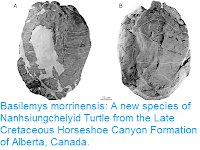Sea Turtles, Chelonioidea, are the most ancient group of living Marine Tetrapods, with s fossil record dating back about 90 million years. However, the exact age of the group is debatable, as it is not clear which fossil species should be included within the Crown Group Turtles (i.e. the group that includes everything descended from the last common ancestor of all living Sea Turtles), and which species represent Stem Group Turtles (i.e. members of groups which branched off from the main Turtle lineage before the last common ancestor of all all living Sea Turtles, and which may therefore represent separate invasions of the marine environment. In particular the position of the Protostegids, a group of marine Turtles that appear in the fossil record around 30 million years before any other marine Turtle group, is considered highly problematic, as the Protostegids appear 30 million years before any other Marine Turtle group.
In a paper publishd in the journal Royal Society Open Science on 18 December 2019, Andrew Gentry of the Department of Biology at the University of Alabama at Birmingham, and the Department of Collections at the McWane Science Center, and Jun Ebersole and Caitlin Kiernan, also of the Department of Collections at the McWane Science Center, describe a new species of fossil Turtle from the Late Cretaceous Demopolis Chalk of Alabama and Mississippi.
The Demopolis Chalk outcrops across a wide area of Alabama, Mississippi, and Tennessee, and comprises calcareous marine sediments laid down in the outer part of the Mississippi Embayment during the Campanian Stage (roughly 80 to 75 million years ago). The formation produces a range of vertebrate fossils, including Dinosaurs, Marine Reptiles, Sharks, and Bony Fish.
The new species is named Asmodochelys parhami, where 'Asmodochelys' means 'Asmodaios-Turtle', in reference to Asmodaios, a Demon in Christian, Jewish, and Islamic mythology who is associated with the sin of lust, and who, according to Islamic legend, was entombed in stone on the sea floor by King Solomon, and 'parhami' honours James Parham, former Curator of Palaeontology at the Alabama Museum of Natural History. The species is described from three partial Turtle shells, the most complete one (MSC 35984) coming from Alberta in Wilcox County, Alabama and the others from Sumter County in Alabama (MSC 40935), and Oktibbeha County in Mississippi (MMNS 3958).
The Wilcox County specimen comprises the nuchal, four neurals, two epineurals, eight left peripherals, five right peripherals, a partial first suprapygal, two costals of the left side, two costals of the right side, and approximately half of the left hyoplastron (all scutes of the shell), plus one cervical vertebra, while the Sumter County comprises one complete costal, three medial peripherals, four posterior peripherals, three neurals, two epineurals, the first suprapygal and the left xiphiplastron, and the Oktibbeha County specimen comprises two left peripherals, one neural, one epineural, both suprapygals and a complete pygal. These Turtles are reconstructed as having been between 1.0 and 1.5 m in length.
Representative elements and composite reconstruction of Asmodochelys parhami. (a) Nuchal, first and second left peripherals, and first right peripheral (MSC 35984) in dorsal view. (b) Third right peripheral (MSC 35984) in dorsal view. (c) Second right costal (MSC 35984) in dorsal view. (d), (e) Fourth neural and second epineural (MSC 35984) in dorsal (d ) and left lateral (e) views. (f) First and second neural (MSC 35984) in dorsal view. (g) Fourth right costal (MSC 35984) in dorsal view. (h), (i) Fifth right peripheral in posterior (h) and dorsal (i) views. (j), (k) Fourth left peripheral (MSC 35984) in dorsal (j) and posterior (k) views. (l), (m) Seventh right peripheral (MSC 35984) in posterior (l) and dorsal (m) views. (n), (o) Fifth left peripheral (MSC 35984) in dorsal (n) and posterior (o) views. (p), (q) Sixth neural and third epineural (MSC 35984) in dorsal ( p) and right lateral (q) views. (r,s) Sixth left peripheral (MSC 35984) in dorsal (r) and posterior (s) views. (t) Fifth left costal (MSC 35984) in dorsal view. (u) Seventh neural (MSC 35984) in dorsal view. (v) First suprapygal (MSC 35984) in dorsal view. (w) Sixth right costal (MSC 35984) in dorsal view. (x) Suprapygals and pygal (MMNS 3958) in dorsal view. (y) Tenth left peripheral (MMNS 3958) in posterior view. (z) Eighth–tenth right peripherals (MMNS 3958) in dorsal view. Dashed lines represent scute sulci. Gentry et al. (2019).
Asmodochelys parhami is condired to be a member of the Ctenochelyidae, a group characterised by a laterally serrated shell, extensive costal and plastral fontanelles, and the presence of epineurals positioned at various intervals along the neural series. A phylogenic reconstruction for the group including Asmodochelys parhami suggests that the Ctenochelyidae are the sister group to the Crown Group Chelonioidea, with the Protostegids being the sister group to the Ctenochelyidae plus the Crown Group Chelonioidea.
See also...
Follow
Sciency Thoughts on Facebook.







